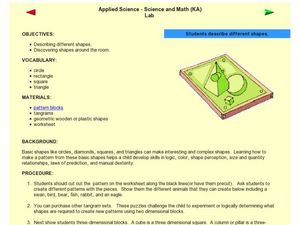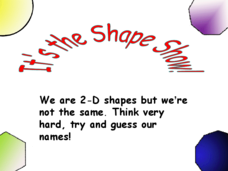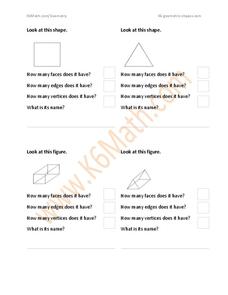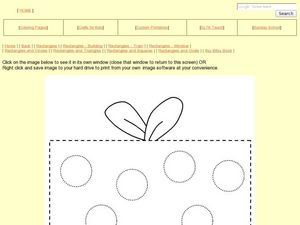Curated OER
Applied Science - Science and Math (K) Lab
In this shape instructional activity, learners cut out tangram shapes and create different pictures with them. They look at 3-D shapes as well. There is a nice, hands-on component built into this instructional activity.
Inside Mathematics
Expressions
Strive to think outside of the quadrilateral parallelogram. Worksheet includes two problems applying prior knowledge of area and perimeter to parallelograms and trapezoids. The focus is on finding and utilizing the proper formula and...
Curated OER
Dilations and Similarity
In this dilations and similarity activity, pupils solve 10 different problems that include various dilations. First, they determine the scale factor of dilations found in the illustrated graphs. Then, everyone determines the coordinates...
Curated OER
The Shape Show
Define plane shapes by their properties, then use this game to reinforce those skills. Learners use given properties as clues to determine each shape. They work to name ten different shapes, six of which are polygons.
Illustrative Mathematics
Grandfather Tang's Story
It's amazing the complex figures that can be made using only a few simple shapes. Following a class reading of the children's book Grandfather Tang's Story by Ann Tompert, young mathematicians use sets of tangrams to create models...
EngageNY
End-of-Module Assessment Task - Geometry (module 1)
Have you hit a wall when trying to create performance task questions? Several open-ended response questions require a deep level of thinking. Topics include triangle congruence, quadrilaterals, special segments, constructions, and...
EngageNY
Composite Area Problems
The 21st segment in a 28-part series provides learners with area problems involving composite figures. To find the solution, pupils must decide whether to add or subtract areas. The composite figures are composed of quadrilaterals,...
Curated OER
Shapes and Colors
In this shapes and colors worksheet, students analyze a picture of a house that is made with squares, rectangles and triangles. Students follow the directions to trace and color each of the geometric shapes they find in the picture.
Curated OER
Figure Analysis
Students identify the importance of the Principles and Elements of design through self-analysis and sketching clothing appropriate for their body type. They write the actual color name on a line of the included sheet, then describe why...
Curated OER
7th Grade Mathematics Booklet
In this 7th grade mathematics compilation worksheet, 7th graders solve and complete 40 various types of mathematics problems. They determine the measure of various angles and the side-lengths in integers of a square. Students also...
Curated OER
Recognize Rectangles
In this shape identification instructional activity, students are shown a page of different shapes and they are to colour all of the rectangles on the page.
Curated OER
Number & Operations
In this number and operations worksheet, students solve and complete 3 different sections of one problem that uses the Pythagorean theorem to solve. They use the model illustrated to determine the meaning of the Pythagorean theorem....
Curated OER
Learning by Logic - Total Surface Area
Geometers calculate the area of plane surfaces using the formulas for the area of a square, rectangle, and triangle. They develop the formula for calculating the total surface area of two geometric solids: the cube and rectangular prism.
Curated OER
Geometric Shapes and Figures
Are your mathematicians figuring out the difference between shapes and figures? Using a simple, visual identification worksheet, learners analyze 2 shapes and 2 figures, answering 4 questions about each. Learners determine their...
Curated OER
Guess My Shape
Learners play a game with shapes. They work in groups to identify the names and characteristics of various shapes. They give each other clues to see if others can identify the shape being described. This is a great hands on activity.
Curated OER
Similarity and Dilations - Discover Properties of Similar Figures
Learners investigate properties of similar figures. In this properties of similar figures lesson, pupils construct similar figures using Cabri Jr. They dilate their figure to create a similar one, and discuss the relationships between...
Curated OER
Shapes and Color: Rectangles and Triangles
In this shape and color worksheet, students trace rectangles, coloring them pink, then trace circles, coloring them purple. Students then trace and color a set of 6 circles.
Curated OER
Classifying Polygons
Students study polygons. In this math lesson, students play a game in which they learn the classification system for polygons. Students identify the properties of quadrilaterals.
Curated OER
Introducing Polygons
In this polygons instructional activity, students name the 6 different colored shapes, choose any 3 polygons to draw and color on a grid, while adding a right angled triangle and a rhombus.
Curated OER
Sum of Angles
In this sum of angles worksheet, 6th graders solve and complete 6 different types of problems. First, they identify different alternate and corresponding angles. Then, students state what the angles of a triangle add up to and how they...
Curated OER
Tessellations
In this tessellations learning exercise, 10th graders solve 6 different types of tessellation problems that includes drawing. First, they define polygon, regular polygon, tessellation, regular tessellation, and semi-regular tessellation....
Curated OER
Polygons
In this polygons worksheet, 4th graders identify and name the 4 polygons drawn on the bottom of the worksheet and then draw a triangle, hexagon and a quadrilateral.
Curated OER
Classifying Shapes Using Venn Diagrams
In this classifying shapes using Venn diagrams worksheet, students draw examples of isosceles, right, and equilateral triangles in the proper sections of the first graphic organizer. They draw polygons, both regular and quadrilaterals,...
Curated OER
Proofs in Coordinate Geometry
In this coordinate geometry activity, students identify the lengths of a quadrilateral and find the slope of a line. They use proofs to identify the characteristics of given quadrilaterals. This one-page activity contains ten problems.























